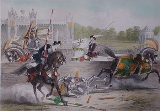
Eglinton Tournament of 1839
Encyclopedia
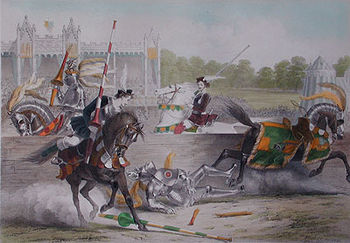
.jpg)
Jousting
Jousting is a martial game or hastilude between two knights mounted on horses and using lances, often as part of a tournament.Jousting emerged in the High Middle Ages based on the military use of the lance by heavy cavalry. The first camels tournament was staged in 1066, but jousting itself did not...
and revel held in Scotland
Scotland
Scotland is a country that is part of the United Kingdom. Occupying the northern third of the island of Great Britain, it shares a border with England to the south and is bounded by the North Sea to the east, the Atlantic Ocean to the north and west, and the North Channel and Irish Sea to the...
on Friday 30 August.
It was funded and organized by Archibald Montgomerie, 13th Earl of Eglinton
Archibald Montgomerie, 13th Earl of Eglinton
Sir Archibald William Montgomerie, 13th Earl of Eglinton KT, PC , known as Lord Montgomerie from 1814 to 1819, was a British Conservative politician...
, and took place at Eglinton Castle
Eglinton Castle
Eglinton Castle was a large Gothic castellated mansion in Kilwinning, North Ayrshire, Scotland.-The castle :The ancient seat of the Earls of Eglinton, it is located just south of the town of Kilwinning...
, near Kilwinning
Kilwinning
Kilwinning is a historic town in North Ayrshire, Scotland. It is known as The Crossroads of Ayrshire. The 2001 Census recorded it as having a population of 15,908.-History:...
in Scotland. The Queen of Beauty
Beauty contest
A beauty pageant or beauty contest, is a competition that mainly focuses on the physical beauty of its contestants, although such contests often incorporate personality, talent, and answers to judges' questions as judged criteria...
was Georgiana Sheridan, the wife of Edward Seymour, 12th Duke of Somerset
Edward Seymour, 12th Duke of Somerset
Sir Edward Adolphus Seymour , 12th Duke of Somerset, etc. KG, PC , styled Baron Seymour until 1855, was a British Whig aristocrat and politician, who served in various cabinet positions in the mid-19th century...
and sister of noted author Caroline Norton
Caroline Elizabeth Sarah Norton
Caroline Elizabeth Sarah Norton was a famous British society beauty, feminist, social reformer, and author of the early and mid nineteenth century.-Youth and Marriage:...
. Many distinguished visitors took part, including the future Napoleon III of France
Napoleon III of France
Louis-Napoléon Bonaparte was the President of the French Second Republic and as Napoleon III, the ruler of the Second French Empire. He was the nephew and heir of Napoleon I, christened as Charles Louis Napoléon Bonaparte...
.
Widely publicized and open to the public, it was a deliberate set piece of Romanticism
Romanticism
Romanticism was an artistic, literary and intellectual movement that originated in the second half of the 18th century in Europe, and gained strength in reaction to the Industrial Revolution...
, in the face of widespread social and ideological upheaval experienced by Europe during the 1830s. A hugely popular and significant phenomenon (planned for 4,000 people, it drew 100,000 spectators; significant impact on attitudes to gothic revival; gigantic boost to local economy), the Eglinton Tournament is primarily famous today by way of the ridicule poured on it by those of politically late Whig/Liberal
Liberal Party (UK)
The Liberal Party was one of the two major political parties of the United Kingdom during the 19th and early 20th centuries. It was a third party of negligible importance throughout the latter half of the 20th Century, before merging with the Social Democratic Party in 1988 to form the present day...
motivation and by many of their successors today. Problems were caused by rainstorms of freak severity. And yet it would be untrue to claim that period critics were necessarily absolute in their condemnation: “Whatever opinion may be formed of the success of the Tournament, as an imitation of ancient manners and customs, we heard only one feeling of admiration expressed at the gorgeousness of the whole scene, considered only as a pageant. Even on Wednesday, when the procession was seen to the greatest possible disadvantage, the dullest eye glistened with delight as the lengthy and stately train swept into the marshalled lists". (Aikman 1839). Despite contemporary ridicule being better remembered today than its successes, it was a real tournament, participants having attended regular training during the course of the year prior. Indeed, when one high spirited combat exceeding these regulations it so stood out for doing so that it was soundly mocked in the press for the enthusiastic violence of the participants.
To understand the actual significance of the phenomenon of the Eglinton Tournament one must understand that it was not an event lasting just a few days: the years of planning, the numerous training sessions before a private audience in St John’s Wood and very public promenading in Regent’s Park before and after these practices, the many works of art both commissioned for and inspired by the Eglinton Tournament, a number of which were copied industrially to satisfy widespread enthusiasm for the event all had a significant effect on public feeling throughout Britain and no small effect on the course of 19th century gothic revivalism. The Eglinton Tournament, had been far more ambitious than previous tournament festivals in Europe since the rise of neo-gothic revival in the 1750s, not just in size, but in terms of its efforts to achieve an exercise that reflected ever more accurate perceptions of the past. In this way, the massive and ambitious Eglinton Tournament, via events of ever increasing attention to archaeological accuracy such as the lavish Tournament of Brussels in 1905, was an important and pioneering stage in a continuum that has resulted in the educational and entertainment industry of multi-period Historical reenactment
Historical reenactment
Historical reenactment is an educational activity in which participants attempt torecreate some aspects of a historical event or period. This may be as narrow as a specific moment from a battle, such as the reenactment of Pickett's Charge at the Great Reunion of 1913, or as broad as an entire...
of the present. It is true that many features of the tournament were inspired by specifics from the tournament conjured by Sir Walter Scott
Walter Scott
Sir Walter Scott, 1st Baronet was a Scottish historical novelist, playwright, and poet, popular throughout much of the world during his time....
's novel Ivanhoe
Ivanhoe
Ivanhoe is a historical fiction novel by Sir Walter Scott in 1819, and set in 12th-century England. Ivanhoe is sometimes credited for increasing interest in Romanticism and Medievalism; John Henry Newman claimed Scott "had first turned men's minds in the direction of the middle ages," while...
rather than from primary evidence but the Eglinton “tournament was attempting to be a living re-enactment of the literary romances” (Watts, 2009) and not an early exercise in experimental archaeology.
In Eglinton’s own words “I am aware of the manifold deficiencies in its exhibition — more perhaps than those who were not so deeply interested in it; I am aware that it was a very humble imitation of the scenes which my imagination had portrayed, but I have, at least, done something towards the revival of chivalry”. (Literary Gazette, 1831:90).
That Eglinton's project still has such power to move, and was followed by equally grand (and more historically accurate) efforts in the last century and is now an ancestor to today's growth industry of 'Living History' is especially interesting given Lord Eglinton's own over-modest evaluation of his efforts' impact when he wrote "I cannot hope that this attempt of mine will be followed".
It is also generally neglected that the event successfully brought incredible sums of money (one contemporary source estimated as much as £500,000) to the area around Irvine in Ayrshire. The only person to have made an actual loss was Lord Eglinton himself who none can claim to have set out to profit from the project anyway. (Watts, 2009) The Earl's grand-daughter, Viva Montgomerie recalls in her memoirs that due to the tournament the family resources had been badly degraded, believing that he had spent most of the wealth of the estate.
Background
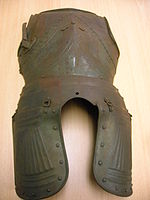
Gothic fiction
Gothic fiction, sometimes referred to as Gothic horror, is a genre or mode of literature that combines elements of both horror and romance. Gothicism's origin is attributed to English author Horace Walpole, with his 1764 novel The Castle of Otranto, subtitled "A Gothic Story"...
, such as The Castle of Otranto
The Castle of Otranto
The Castle of Otranto is a 1764 novel by Horace Walpole. It is generally regarded as the first gothic novel, initiating a literary genre which would become extremely popular in the later 18th century and early 19th century...
, by Horace Walpole (1717–1797) and the many works of Sir Walter Scott popularised the idea of passionate romanticism and praise of chivalric ideals
Chivalry
Chivalry is a term related to the medieval institution of knighthood which has an aristocratic military origin of individual training and service to others. Chivalry was also the term used to refer to a group of mounted men-at-arms as well as to martial valour...
. Walpole himself was one of the first in England to renovate his mansion into a mock-Gothic castle, Strawberry Hill
Strawberry Hill House
Strawberry Hill is the Gothic Revival villa of Horace Walpole which he built in the second half of the 18th century in what is now an affluent area of the London Borough of Richmond upon Thames in Twickenham, London...
(1749–1777).
Medieval culture was widely admired as an antidote to the modern enlightenment
Age of Enlightenment
The Age of Enlightenment was an elite cultural movement of intellectuals in 18th century Europe that sought to mobilize the power of reason in order to reform society and advance knowledge. It promoted intellectual interchange and opposed intolerance and abuses in church and state...
and industrial age
Industrial Age
Industrial Age may refer to:*Industrialisation*The Industrial Revolution...
. Plays and theatrical works (such as Ivanhoe
Ivanhoe
Ivanhoe is a historical fiction novel by Sir Walter Scott in 1819, and set in 12th-century England. Ivanhoe is sometimes credited for increasing interest in Romanticism and Medievalism; John Henry Newman claimed Scott "had first turned men's minds in the direction of the middle ages," while...
, which in 1820 was playing in six different productions in London
London
London is the capital city of :England and the :United Kingdom, the largest metropolitan area in the United Kingdom, and the largest urban zone in the European Union by most measures. Located on the River Thames, London has been a major settlement for two millennia, its history going back to its...
alone) perpetuated the romanticism of knights, castles, feasts and tournaments. Caspar David Friedrich
Caspar David Friedrich
Caspar David Friedrich was a 19th-century German Romantic landscape painter, generally considered the most important German artist of his generation. He is best known for his mid-period allegorical landscapes which typically feature contemplative figures silhouetted against night skies, morning...
(1774–1840) of Germany painted magnificent Gothic ruins and spiritual allegories. Jane Austen
Jane Austen
Jane Austen was an English novelist whose works of romantic fiction, set among the landed gentry, earned her a place as one of the most widely read writers in English literature, her realism and biting social commentary cementing her historical importance among scholars and critics.Austen lived...
(1775–1815) wrote her novel Northanger Abbey
Northanger Abbey
Northanger Abbey was the first of Jane Austen's novels to be completed for publication, though she had previously made a start on Sense and Sensibility and Pride and Prejudice. According to Cassandra Austen's Memorandum, Susan was written approximately during 1798–99...
(written 1798, published 1817) as a satire on romantic affectation.

Pennon
A pennon was one of the principal three varieties of flags carried during the Middle Ages . Pennoncells and streamers or pendants are considered as minor varieties of this style of flag. The pennon is a flag resembling the guidon in shape, but only half the size...
and spear of Harry Hotspur, aka Sir Henry Percy, at the Battle of Otterburn
Battle of Otterburn
The Battle of Otterburn took place on the 5 August 1388, as part of the continuing border skirmishes between the Scottish and English.The best remaining record of the battle is from Jean Froissart's Chronicles in which he claims to have interviewed veterans from both sides of the battle...
by a Montgomerie. The price for Hotspur's release was the building of the castle of Polnoon
Polnoon Castle
Polnoon Castle was a 14th century fortification located on a motte beside the Polnoon Water in the Parish of Eaglesham, East Renfrewshire, Scotland.-The Montgomerys of Eaglesham:...
in Eaglesham
Eaglesham
Eaglesham , is a village and parish set in the west central Lowlands of Scotland - population 3,127 . Today it is chiefly a dormitory town for commuters to nearby Glasgow. The village is distinctive in being based around a large triangular green...
, Renfrewshire for the Montgomeries. It is said that the Duke of Northumberland
Duke of Northumberland
The Duke of Northumberland is a title in the peerage of Great Britain that has been created several times. Since the third creation in 1766, the title has belonged to the House of Percy , which held the title of Earl of Northumberland from 1377....
, head of the Percy family, made overtures for the return of the pennon in 1839 and was given the answer, "There's as good lea land at Eglinton as ever there was at Chevy Chase (Otterburn); let Percy come and take them."
In 1838 Whig
British Whig Party
The Whigs were a party in the Parliament of England, Parliament of Great Britain, and Parliament of the United Kingdom, who contested power with the rival Tories from the 1680s to the 1850s. The Whigs' origin lay in constitutional monarchism and opposition to absolute rule...
Prime Minister Lord Melbourne announced that the coronation of Queen Victoria would not include the traditional medieval-style banquet in Westminster Hall. Seeking to disempower the monarchy in particular and romantic ideology and politics in general was a normal activity for the Whig party, so, in the face of recession, the more obviously anachronistic parts of the coronation celebrations would be considered an extravagance. Furthermore, memories of embarrassing mishap at George IV's Westminster Hall banquet were still fresh; uproar having resulted when, at the end of the proceedings, people tried to obtain valuable tableware as souvenirs. King William IV had cancelled his banquet to prevent a repeat. Although there was some popular support for government refusal to hold the traditional event, there were "many complaints and various public struggles, as well as on the part of the antiquaries, as on that of the tradesmen of the metropolis". Critics referred to Victoria's slimmed-down coronation scornfully as "The Penny Crowning". Despite attempts to achieve economies, contemporary accounts point out that Victoria's coronation in fact cost £20,000 more than that of George IV
George IV of the United Kingdom
George IV was the King of the United Kingdom of Great Britain and Ireland and also of Hanover from the death of his father, George III, on 29 January 1820 until his own death ten years later...
. Nevertheless, her coronation did feature an innovation: the procession from the palace to Westminster Abbey
Westminster Abbey
The Collegiate Church of St Peter at Westminster, popularly known as Westminster Abbey, is a large, mainly Gothic church, in the City of Westminster, London, United Kingdom, located just to the west of the Palace of Westminster. It is the traditional place of coronation and burial site for English,...
, which was very popular.
However, it was not just the ancient Great Feast itself which had been cancelled but also other rituals which traditionally were not paid for by the state anyway such as the throwing down of the gauntlet by the Queen's Champion, and his symbolic presentation to her of two falcons. "Obeisance to the past was in 1839 was not just a fad; for some, it was an urgent need". Lord Eglinton’s own stepfather, Sir Charles Montolieu Lamb, 2nd Baronet, as Knight Marshal
Knight Marshal
The Knight Marshal is a former office in the British Royal Household established by King Henry III in 1236. The position later became a Deputy to the Earl Marshal from the reign of Henry VIII until the office was abolished in 1846 ....
of the Royal Household, would have led his horse into the Great Hall of Westminster as part of one of these colourful and widely loved rituals. On August 4, 1838, the "Court Journal" printed a rumour that Archibald William Montgomerie, 13th Earl of Eglinton, was going to host a great jousting tournament at his castle in Scotland
Scotland
Scotland is a country that is part of the United Kingdom. Occupying the northern third of the island of Great Britain, it shares a border with England to the south and is bounded by the North Sea to the east, the Atlantic Ocean to the north and west, and the North Channel and Irish Sea to the...
. It has been speculated that it was Sir Charles or his son who suggested to Lord Eglinton that he should provide the nation with its missing rites of passage by holding a great mediaeval festival himself, but whatever the details, within a few weeks Eglinton had confirmed the rumour true.
At first the suggestion was that mediaeval games would be held at the next private race meeting at Eglinton, including the ceremony of the challenge carried out by a knight clad in armour.
Preparation
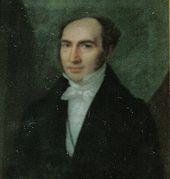

Plate armour
Plate armour is a historical type of personal armour made from iron or steel plates.While there are early predecessors such the Roman-era lorica segmentata, full plate armour developed in Europe during the Late Middle Ages, especially in the context of the Hundred Years' War, from the coat of...
at No. 47 Bond Street, London. Many backed out when they realised the astronomical costs and difficulties, but "about forty" were determined to try regardless. Pratt was to be in charge of all the arrangements, the pavilions and armour, banners, decor and costumes. He also would supply the stands, marquees and great tents for the feast and ball. Although all the armour supplied by Pratt was supposed to have been genuinely medieval, it is unclear how many of the suits actually were; the only armour that was kept track of, that of the 3rd Marquess of Waterford, on display in 1963 at Windsor Castle, is a pastiche. Some of the armour used was on loan from the Tower of London
Tower of London
Her Majesty's Royal Palace and Fortress, more commonly known as the Tower of London, is a historic castle on the north bank of the River Thames in central London, England. It lies within the London Borough of Tower Hamlets, separated from the eastern edge of the City of London by the open space...
and, not realising at that time that changes in diet and health since the late Middle Ages had increased average stature, it was noted with interest that mostly the suits were too small and had to be let out before they could be worn. The family sold the Earl of Eglinton's own armour during the 1925 sale of the castle contents.
The dress rehearsals were held in London at a garden behind the Eyre Arms, St John's Wood, a tavern close to Regent's Park
Regent's Park
Regent's Park is one of the Royal Parks of London. It is in the north-western part of central London, partly in the City of Westminster and partly in the London Borough of Camden...
, the last one on Saturday, July 13, 1839. Nineteen knights participated. The audience was invitation only; many of "the very elite of the most elite" (said the "Court Journal") were invited to watch, and 2,690 attended. The rehearsal went perfectly. The weather was sunny, the banners and armour and tents impressive, the jousting successful. Even critics conceded that the tournament was likely to be a fine show.
Mass-production of memoribilia copies of artworks commissions for the tournament demonstrated that it was not only upper-class Britain that took notice. Tories eyed antique armour and dreamed of courtly love
Courtly love
Courtly love was a medieval European conception of nobly and chivalrously expressing love and admiration. Generally, courtly love was secret and between members of the nobility. It was also generally not practiced between husband and wife....
, and Queen Victoria twice noted in her diary that she had discussed the tournament with Lord Melbourne and although her view was that the event would be a foolish amusement, the choice of Lady Seymour as Queen of Beauty was to her liking. With only two months to live that tragic figure, Lady Flora Hastings
Lady Flora Hastings
Lady Flora Elizabeth Rawdon-Hastings was a British aristocrat and lady-in-waiting to Queen Victoria's mother, the Duchess of Kent, whose death in 1839 caused a court scandal that gave the Queen a negative image....
, wrote in 1839 to her mother on the subject of the upcoming Eglinton Tournament, expressing her concern that one of the knights might be killed in the violent sport.
On the other hand the Whigs, the social reformers, and the Utilitarians expressed outrage at such a fantasy at a time when the economy was in a shambles, when poverty was rampant and many workers were starving. Emotions ran high, with satirical cartoons, insults and passions aroused on both sides, the Whigs calling the Tories wastrels and the Tories calling the Whigs heartless. Whatever Eglinton's original intent, the tournament was symbolic of romantic defiance in the face of the spirit of revolution that was frightenting so much of old guard Europe during the second quarter of the 19th century.
Terrain

The Tournament was held on a meadow or holm at a loop in the Lugton Water
River Irvine
The River Irvine is a river flowing through southwest Scotland, with its watershed on the Lanarkshire border of Ayrshire at an altitude of above sea-level, near Drumclog, and SW by W of Strathaven...
. The ground chosen for the tournament was low, almost marshy, with grassy slopes rising on all sides. The Knights on horseback and their retinue reached the tilt yard
Tiltyard
A tiltyard was an enclosed courtyard for jousting . Tiltyards were a common feature of late medieval castles and palaces...
('C' on the map) via an enclosed ride ('G' on the map), whilst the guests and visitors made their way to the stands via the route marked 'F' on the map illustrated. Both groups crossed over the three arched Gothic Eglinton Tournament Bridge
Eglinton Tournament Bridge
The Eglinton Tournament Bridge is a bridge located within Eglinton Country Park near Kilwinning, North Ayrshire, Scotland. The bridge crosses the Lugton Water a short distance northwest of Eglinton Castle and was named after the Eglinton Tournament of 1839...
. An 1837 map of Eglinton Castle, Grounds and Tilt yard shows that the tilt yard was already in extistence at this early date, but it is not recorded what its fate was after the tournament was over.
Crowds
Lord Eglinton announced that the public would be welcome; he requested medieval fancy dress, if possible, and tickets were free but would have to be applied for. Expecting a healthy turnout — the Eglinton race meetings generally got local audiences of up to 1500 — he made arrangements for grandstands for the guests and comfortable seating for the expected crowd of about 4000. He notified the press (The TimesThe Times
The Times is a British daily national newspaper, first published in London in 1785 under the title The Daily Universal Register . The Times and its sister paper The Sunday Times are published by Times Newspapers Limited, a subsidiary since 1981 of News International...
, the Morning Post
Morning Post
The Morning Post, as the paper was named on its masthead, was a conservative daily newspaper published in London from 1772 to 1937, when it was acquired by The Daily Telegraph.- History :...
, the Court Gazette, and "the other important or popular journals") of the offer of free tickets to all.
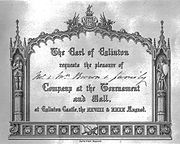
Sheffield Iris
The Sheffield Iris was an early weekly newspaper published on Tuesdays in Sheffield, England.The first newspaper to be published in Sheffield to see any degree of success was the Sheffield Weekly Journal in 1754...
, the Wisbech Star in the East and many other newspapers — readers "from every county in the British Isles" — applied to Lord Eglinton for tickets. Through the month of August letters came by the hundreds into Castle Eglinton requesting tickets for parties of twenty, fifty, a hundred people.
A scrapbook of nearly a thousand of these letters still survives, filled with pleas, anecdotes, promises of medieval dress, and assertions of Tory sympathies. Lord Eglinton accepted the challenge, issued the requested tickets and planned for a vastly larger effort.
Transportation and lodgings
With a turnout two orders of magnitude greater than expected (the final estimate was a crowd of one hundred thousand), area transportation — even though recently modernised — and lodgings were overwhelmed. The nearby town of Irvine had only one hotel. Private homes were able to charge very high prices to take in the tourists. On the morning of the tournament the roads to Eglinton Castle were quickly jammed. The road from AyrAyr
Ayr is a town and port situated on the Firth of Clyde in south-west Scotland. With a population of around 46,000, Ayr is the largest settlement in Ayrshire, of which it is the county town, and has held royal burgh status since 1205...
to Glasgow
Glasgow
Glasgow is the largest city in Scotland and third most populous in the United Kingdom. The city is situated on the River Clyde in the country's west central lowlands...
(thirty miles long) was filled end to end, and every approach was blocked by abandoned carriages, their owners continuing on foot. The railway from Ayr to Irvine charged thrice the normal fee; people fought for the tickets, as it was the only transport guaranteed to deposit them only a few miles from the castle. Some poor folk without lodgings are said to have spent the first night beneath the grandstand or even in hollow tree-trunks. The situation must have born a striking resemblance to infamous transport and accommodation problems experienced in 1969 at the Woodstock Festival
Woodstock Festival
Woodstock Music & Art Fair was a music festival, billed as "An Aquarian Exposition: 3 Days of Peace & Music". It was held at Max Yasgur's 600-acre dairy farm in the Catskills near the hamlet of White Lake in the town of Bethel, New York, from August 15 to August 18, 1969...
.
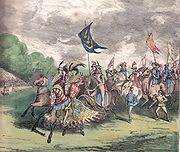
The Tournament
The intended day was August 29, but steady rain caused a postponement.The opening parade comprised forty knights, each with his own entourage who were to ride to the castle, picked up a lady, officer or knight, and returned to the lists, the pictureseque estate drive being lined with thousands of spectators.
Elaborate rehearsals and training in St John’s Wood had not prepared participants for the crowded and already sodden conditions on the day and the opening parade took three hours longer than planned to marshal.
Although the day had dawned clear and fine, as the knights and their entourages struggled to organise the parade the sky began to darken. Just at the moment when the parade was finally arranged — just as Lady Seymour, the Queen of Beauty, was heralded by trumpets — there was a flash of lightning, a great crash of thunder, and the black clouds of Ayrshire let loose with a sudden and violent rainstorm.
Lord Eglinton immediately ordered the ladies into carriages, but the knights and their entourages, soon soaked in the squall and covered in mud, marched into the lists down a parade route lined by the umbrella bearing audience. Ridicule concerning this issue is most inconsistent: some sometime those in costume are put to criticism for seeking to protect their silks and plumes with from the elements (Anstruther makes fun of Charles Stewart, 3rd Marquess of Londonderry
Charles Stewart, 3rd Marquess of Londonderry
Charles William Vane, 3rd Marquess of Londonderry KG, GCB, GCH, PC , styled The Honourable Charles Stewart from 1789 until 1813 and The Honourable Sir Charles Stewart from 1813 to 1814 and known as The Lord Stewart from 1814 to 1822, was a British soldier, politician and nobleman...
for using ”a gigantic green umbrella.”) and sometimes precisely for not doing so (as when the same author carps that few had brought overcoats or umbrellas, despite most were in expensive costumes. ^ a b Anstruther, p. 203).

Unsurprisingly, the unmanageably large crowds did not return on the second day.
Notable participants
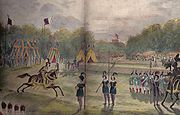
- Viscount Alford, aged 27, "Knight of the Black Lion"
- Captain Beresford, aged 32, "Knight of the Stag's Head"
- the Earl of CassillisArchibald Kennedy, 2nd Marquess of AilsaArchibald Kennedy, 2nd Marquess of Ailsa, KT was a Scottish peer.Born at Dunottar, he was the eldest son of Archibald Kennedy, Earl of Cassilis, himself oldest son of Archibald Kennedy, 1st Marquess of Ailsa, and his wife Eleanor, only child of Alexander Allerdice...
, aged 23, "Knight of the Dolphin" - the Earl of CravenWilliam Craven, 2nd Earl of CravenWilliam Craven, 2nd Earl of Craven , styled Viscount Uffington until 1825, was a British peer.He inherited the earldom in 1825 from his father, William Craven, 1st Earl of Craven...
, aged 30, "Knight of the Griffin" - Captain James O. Fairlie, aged 30, "Knight of the Golden Lion"
- the Hon. H. E. H. Gage, aged 25, "Knight of the Ram"
- Viscount GlenlyonGeorge Murray, 6th Duke of AthollGeorge Augustus Frederick John Murray, 6th Duke of Atholl KT, DL was a Scottish peer and freemason....
, aged 25, "Knight of the Gael" - Sir Francis Hopkins, Bart., aged 26, "Knight of the Burning Tower"
- the Hon. Edward Jerningham, aged 35, "Knight of the Swan"
- Charles Lamb, aged 23, "Knight of the White Rose"
- Richard Lechemere, aged 40, "Knight of the Red Rose"
- Walter Little Gilmour, aged 32, "The Black Knight"
- the Marquess of Waterford, aged 28, "Knight of the Dragon"
- Other participants and guests included
- Lord Shaftesbury
- the Marquess of Londonderry
- Prince Louis Napoleon
- Princess Esterhazy of Hungary
- Count Persigny of France
- Count Lubeski of Poland
- Jane Georgiana, Lady Seymour
Aftermath
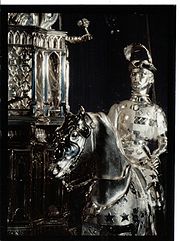
The rains had flooded the Lugton Water, which ran around the Lists on three sides. No carriages could cross it, so the entire audience, apart from Eglinton's personal guests, was stranded without transportation. They had to walk miles through the rain and the mud to nearby villages, where only the first people found any food, drink, accommodation or transport.
It did however succeed in publicity terms. "Perhaps the most spectacular manifestations of the Medievalist movement were the Grand Tournaments; historical pageants featuring elaborate ceremonies, costumes, sets, re-enactments of battles and jousting displays. Between 1750 and 1839 at least eighteen of these events were staged throughout Europe, the final being the Eglinton Tournament. This event stands as one of the most glorious and infamous follies of the 19th century. Although a torrential downpour resulted in the 'knights' and their mounts struggling through mud and sleet, all but invisible to the enormous crowd, Eglinton struck a sympathetic chord in the Victorian imagination. It served to whet the public’s appetite for medieval martial spectacle, and this was partly appeased by a 'Tournament and Siege' produced at Astley’s Amphitheatre a few weeks later." William Gilmor of Baltimore, who was there, the next year introduced tourneys in the USA.
The Eglinton Trophy
Eglinton Trophy
The Eglinton Trophy or Eglinton Testimonial is a Gothic style silver centrepiece presented by friends and admirers to the 13th Earl of Eglinton to commemorate the medieval re-enactment known as the 'Eglinton Tournament' held at Eglinton Castle, Kilwinning, North Ayrshire in 1839.-Fund raising:A...
or Eglinton Testimonial is a Gothic style one metre high silver centrepiece presented to the 13th Earl of Eglinton by friends and admirers to commemorate the 'Eglinton Tournament'.
Panoramas illustrated the tournament, using long strips of painted canvas wound round a tube and slowly unwound to give a view of the event. The venue was Edinburgh in 1839 or 1840.
It inspired a successor event in July 1912.
A local pub was named after the event. The Tourney Inn, located at 119 Fergushill Road, Kilwinning was built in 1968 and demolished in 2008. It was designed in the shape of a twin peaked marquee and contained many internal references to the 1839 tournament.
Armour used at the tournament has been preserved in the Leeds Armoury, Kelvingrove Museum, Dean Castle
Dean Castle
Dean Castle is situated in the Dean Castle Country Park in Kilmarnock, East Ayrshire, Scotland. It was the stronghold for the Boyd Family, who were lords of Kilmarnock for over 400 years....
and elsewhere.
The remnants of the tournament were sold off at a public auction and the glasses and crystal used in the marquees for the medieval ball and feast were sold off soon after. A ship named the 'Eglinton' was partly constructed from the wood used for the jousting arena.
A mid 18th C Scottish 'Basket Hilted Back Sword', the hilt elements including a forward quillon
Quillón
Quillón is a Chilean city and commune and Ñuble Province, Biobío Region.-Demographics:According to the 2002 census of the National Statistics Institute, Quillón spans an area of and has 15,146 inhabitants . Of these, 7,536 lived in urban areas and 7,610 in rural areas...
and an oval rein aperture, from Eglinton Castle, is now in the Royal Ontario Museum
Royal Ontario Museum
The Royal Ontario Museum is a museum of world culture and natural history in Toronto, Ontario, Canada. With its main entrance facing Bloor Street in Downtown Toronto, the museum is situated north of Queen's Park and east of Philosopher's Walk in the University of Toronto...
.
The bow used at the tournament by one of the Cochran-Patrick family of Ladyland House is preserved in the Kilwinning Abbey Tower Museum. This bow was made by David Muir of Kilwinning, using Degame wood, otherwise known as lemonwood.
The flag that flew over the castle bearing the earl's coat of arms was eventually donated to North Ayrshire Council and is now kept in the North Ayrshire Heritage Centre.
Tournament Bridge
This outstanding Gothic bridge was not actually built at the time of the tournament and even the previous bridge, originally located 100 yards further up the river, had been in place for at least 25 years at the time of the tournament. The label Tournament BridgeEglinton Tournament Bridge
The Eglinton Tournament Bridge is a bridge located within Eglinton Country Park near Kilwinning, North Ayrshire, Scotland. The bridge crosses the Lugton Water a short distance northwest of Eglinton Castle and was named after the Eglinton Tournament of 1839...
has stuck, despite the inaccuracy. Contemporary engravings and paintings show that it was however heavily embellished with Gothic additions for the event.
1989 re-enactment
As 1989 was the 150th anniversary of the tournament, the staff of the newly opened Eglinton Country ParkEglinton Country Park
Eglinton Country Park is located in the grounds of the old Eglinton Castle estate, Kilwinning, North Ayrshire, Scotland . Eglinton Park is situated in the parish of Kilwinning, part of the former district of Cunninghame, and covers an area of 400 hectares...
organised a re-enactment which ran over a period of three days in August of that year.
The Tournament
The Banquet and ball
2011 Eglinton Tournament Exhibition
In May 2011 East Ayrshire Council held an exhibition entitled 1839 a Gothic adventure at the Dick Institute, Kilmarnock and published a book with that title. The Eglinton TrophyEglinton Trophy
The Eglinton Trophy or Eglinton Testimonial is a Gothic style silver centrepiece presented by friends and admirers to the 13th Earl of Eglinton to commemorate the medieval re-enactment known as the 'Eglinton Tournament' held at Eglinton Castle, Kilwinning, North Ayrshire in 1839.-Fund raising:A...
was loaned by the Earl of Eglinton and North Ayrshire Council for the duration. Two medals produced to commemorate the 1839 exhibition were on display.
2014 event
The 175th anniversary of the Eglinton Tournament will be in 2014 and the North Ayrshire Heritage Centre and Eglinton Country Park are already planning events to commemorate the occasion.See also
- Gothic Revival
- JoustingJoustingJousting is a martial game or hastilude between two knights mounted on horses and using lances, often as part of a tournament.Jousting emerged in the High Middle Ages based on the military use of the lance by heavy cavalry. The first camels tournament was staged in 1066, but jousting itself did not...
- Medieval reenactmentMedieval reenactmentMedieval reenactment is a form of historical reenactment that focuses on re-enacting European history in the period from the fall of Rome to about the end of the 15th century. The second half of this period is often called the Middle Ages...
- RomanticismRomanticismRomanticism was an artistic, literary and intellectual movement that originated in the second half of the 18th century in Europe, and gained strength in reaction to the Industrial Revolution...
- Eglinton TrophyEglinton TrophyThe Eglinton Trophy or Eglinton Testimonial is a Gothic style silver centrepiece presented by friends and admirers to the 13th Earl of Eglinton to commemorate the medieval re-enactment known as the 'Eglinton Tournament' held at Eglinton Castle, Kilwinning, North Ayrshire in 1839.-Fund raising:A...
- Eglinton Country ParkEglinton Country ParkEglinton Country Park is located in the grounds of the old Eglinton Castle estate, Kilwinning, North Ayrshire, Scotland . Eglinton Park is situated in the parish of Kilwinning, part of the former district of Cunninghame, and covers an area of 400 hectares...
- Eglinton Tournament bridgeEglinton Tournament BridgeThe Eglinton Tournament Bridge is a bridge located within Eglinton Country Park near Kilwinning, North Ayrshire, Scotland. The bridge crosses the Lugton Water a short distance northwest of Eglinton Castle and was named after the Eglinton Tournament of 1839...

